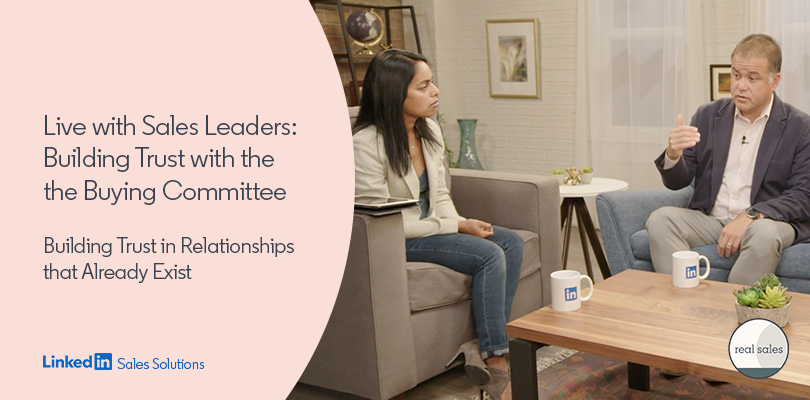Live with Sales Leaders: Building Trust in Relationships that Already Exist
In the second installment of our “Live with Sales Leaders: Building Trust in the Buying Committee” blog series, we explore how to strengthen already-existing relationships with your customers.
In this episode, Vidya Drego (Head of Product Marketing, LinkedIn Sales Solutions), Craig Rosenberg (Co-founder and Chief Analyst at TOPO), and Dan Gottlieb (Analyst-Sales Development Practice at TOPO) dive into a big question — How can sales professionals make the trust in relationships last?
Treat Your Customers Like Your Prospects – Keep Talking & Multi-threading
“Only good things happen when you talk to your customers,“ says Rosenberg. It’s far better for salespeople to do the work of keeping customers in the loop versus leaving them out in the dark, he says.
The hard truth is that many sales organizations are not proactive or strategic when it comes to checking in on their existing customers. More often than not, it’s only until the account teams are hit with the realization that they haven’t talked to their customers in a while that they scramble to organize tactical activities such as a Quarterly Business Report.
So the first step is for salespeople to start being intentional and structured with when and how they conduct their check-ins. A salesperson must figure out how many touchpoints to create across in-person and digital channels. Then salespeople should assign the appropriate contact for each touchpoint, so that they’re prepared for the best outcome — upside or renewal. Or the worst – such as when someone like your champion leaves the company.
Demonstrate Value Through Speed and Data
Say that the worst-case scenario happens, and your champion leaves the company. “That’s like the danger zone of all danger zones,” Gottlieb says.
After all, your champion loved your product. It was a guaranteed renewal. But now that your champion has left, you need to figure out which levers to pull to express your product’s value faster throughout the organization.
With data, you can also proactively set up warnings and triggers to monitor the account. In the case of big news such as an acquisition or a decision-maker leaving, you can be alerted right away and start figuring out your next move.
Throw in multi-threading — that is connection with a number of decision-makers and influencers at the customer — and you can also formulate an emergency plan and figure out where your products or services can contribute the most value. The data should be able to tell you about the product or service usage, providing a clue on where and when you should go in.
Gottlieb says, “The best reps rarely get surprised even when they are surprised.” Even if something happens, because they’ve done their due diligence to continually build information throughout the sales process, they don’t act out of desperation or blindness. They take great notes, understand every stakeholder in their buying process, and engage with them in a relevant way.
Mix What’s New With What’s Too Good to Be Changed
“There’s a reason why professional services companies love spending money on professional services,” Gottlieb says. They know that the services provided will ultimately contribute to the larger goal in mind, which sellers are proactively anticipating in order to demonstrate their worth.
If you, as the seller, know that your customer is struggling with a larger goal, take the opportunity to jump in and bring them the resources they need to help meet that objective. Run those innovation and insight-driven discussions. But don’t feel overwhelming pressure to come up with an innovative solution every single time. Customers are just as happy to adopt tactics that have consistently worked well for them over time.
Keep pace with the latest thinking in Real Sales and subscribe to the LinkedIn Sales Blog today.
Topics: How I Sell interviews
Related articles






